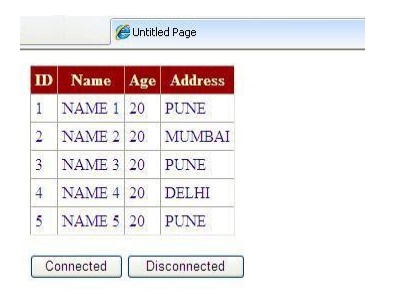Chapter: C# and .NET Framework
ADO.NET Connected and Disconnected Models
ADO.NET Connected and Disconnected Models
Connected
Architecture of ADO.NET
The
architecture of ADO.net, in which connection must be opened to access the data
retrieved from database is called as connected architecture. Connected
architecture was built on the classes connection, command, datareader and
transaction.
Connected
architecture is when you constantly make trips to the database for any CRUD
(Create, Read, Update and Delete) operation you wish to do. This creates more
traffic to the database but is normally much faster as you should be doing
smaller transactions.
Disconnected
Architecture in ADO.NET
The
architecture of ADO.net in which data retrieved from database can be accessed
even when connection to database was closed is called as disconnected
architecture. Disconnected architecture of ADO.net was built on classes
connection, dataadapter, commandbuilder and dataset and dataview.
Disconnected
architecture is a method of retrieving a record set from the database and
storing it giving you the ability to do many CRUD (Create, Read, Update and
Delete) operations on the data in memory, then it can be re-synchronized with
the database when reconnecting. A method of using disconnected architecture is
using a Dataset.
DataReader
is Connected Architecture since it keeps the connection open until all rows are
fetched one by one
DataSet
is DisConnected Architecture since all the records are brought at once and
there is no need to keep the connection alive
Difference
between Connected and disconnected architecture

Connected
It
is connection oriented.
Datareader
Connected
methods gives faster performance
connected
can hold the data of single table
connected
you need to use a read only forward only data reader
Data
Reader can't persist the data
It
is Read only, we can't update the data.
Disconnected
It
is dis_connection oriented.
DataSet
Disconnected
get low in speed and performance.
disconnected
can hold multiple tables of data
disconnected
you cannot
Data
Set can persist the data
We
can update data
Example
Create
Database ―Student‖
[ID]
[int] PRIMARY KEY IDENTITY(1,1) NOT NULL,
[Name] [varchar](255) NULL,
[Age]
[int] NULL,
[Address]
[varchar](255) NULL
)
INSERT INTO Student([Name],[Age],[Address])VALUES('NAME 1','22','PUNE')
INSERT INTO Student([Name],[Age],[Address])VALUES('NAME 2','25','MUMBAI')
INSERT INTO Student([Name],[Age],[Address])VALUES('NAME 3','23','PUNE')
INSERT INTO Student([Name],[Age],[Address])VALUES('NAME 4','21','DELHI')
INSERT INTO Student([Name],[Age],[Address])VALUES('NAME 5','22','PUNE')
HTML
<html xmlns="http://www.w3.org/1999/xhtml">
<head id="Head1" runat="server">
<title>Untitled Pagetitle>
</head>
<body>
<form id="form1" runat="server">
<div>
<asp:GridView ID="GridView1" runat="server" BackColor="White"
BorderColor="#CC9966"
BorderStyle="None" BorderWidth="1px" CellPadding="4"> <FooterStyle BackColor="#FFFFCC" ForeColor="#330099" /> <RowStyle BackColor="White" ForeColor="#330099"
/>
<PagerStyle BackColor="#FFFFCC" ForeColor="#330099" HorizontalAlign="Center"
/>
<SelectedRowStyle BackColor="#FFCC66" Font-Bold="True" ForeColor="#663399" /> <HeaderStyle BackColor="#990000" Font-Bold="True" ForeColor="#FFFFCC"
/>
</asp:GridView>
<br />
<asp:Button ID="Connected" runat="server" OnClick="Connected_Click"
Text="Connected" />
<asp:Button ID="Disconnected" runat="server" EnableTheming="False"
OnClick="Disconnected_Click" Text="Disconnected" />
</div> </form>
</body> </html>
Code
Behind
String StrSQL = "", StrConnection = "";
protected void Page_Load(object sender, EventArgs e)
{
StrSQL = "SELECT * FROM Student";
StrConnection = "Data Source=ServerName;Initial Catalog=Database;User
ID=Username;Password=password";
}
protected void Connected_Click(object sender, EventArgs e)
{
using (SqlConnection objConn = new SqlConnection(StrConnection))
{
SqlCommand objCmd = new SqlCommand(StrSQL, objConn); objCmd.CommandType = CommandType.Text; objConn.Open();
SqlDataReader objDr = objCmd.ExecuteReader(); GridView1.DataSource = objDr;
GridView1.DataBind();
objConn.Close();
}
}
protected void Disconnected_Click(object sender, EventArgs e)
{
SqlDataAdapter objDa = new SqlDataAdapter(); DataSet objDs = new DataSet();
using (SqlConnection objConn = new SqlConnection(StrConnection))
{
SqlCommand objCmd = new SqlCommand(StrSQL, objConn); objCmd.CommandType = CommandType.Text; objDa.SelectCommand = objCmd;
objDa.Fill(objDs,
"Student"); GridView1.DataSource =
objDs.Tables[0]; GridView1.DataBind();
}
}

Related Topics